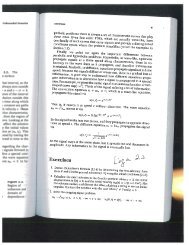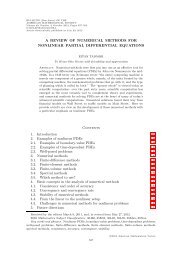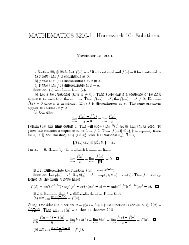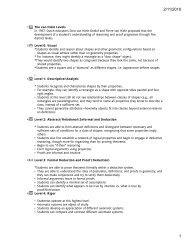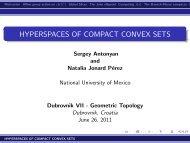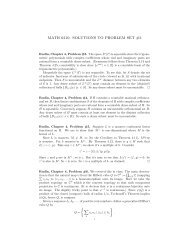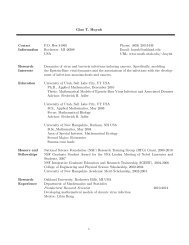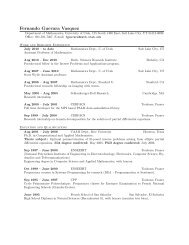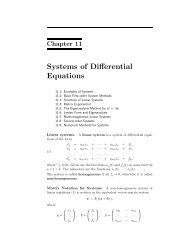A New Construction of the Tame Local Langlands Correspondence ...
A New Construction of the Tame Local Langlands Correspondence ...
A New Construction of the Tame Local Langlands Correspondence ...
Create successful ePaper yourself
Turn your PDF publications into a flip-book with our unique Google optimized e-Paper software.
A <strong>New</strong> <strong>Construction</strong> <strong>of</strong> <strong>the</strong> <strong>Tame</strong> <strong>Local</strong><br />
<strong>Langlands</strong> <strong>Correspondence</strong> for GL(ℓ, F)<br />
Moshe Adrian<br />
Ma<strong>the</strong>matics Department<br />
University <strong>of</strong> Maryland<br />
January 16, 2010<br />
logo<br />
Moshe Adrian A <strong>New</strong> <strong>Construction</strong> <strong>of</strong> <strong>the</strong> <strong>Tame</strong> <strong>Local</strong> <strong>Langlands</strong> <strong>Correspondence</strong> for GL(ℓ, F
Introduction<br />
Metaphilosophy:<br />
Roughly speaking,<br />
Representations <strong>of</strong> G(F) ↭ characters <strong>of</strong> tori T(F) ⊂ G(F)<br />
Examples:<br />
1) F = finite ⇝
Introduction<br />
Metaphilosophy:<br />
Roughly speaking,<br />
Representations <strong>of</strong> G(F) ↭ characters <strong>of</strong> tori T(F) ⊂ G(F)<br />
Examples:<br />
1) F = finite ⇝
Introduction<br />
Metaphilosophy:<br />
Roughly speaking,<br />
Representations <strong>of</strong> G(F) ↭ characters <strong>of</strong> tori T(F) ⊂ G(F)<br />
Examples:<br />
1) F = finite ⇝
Introduction<br />
Metaphilosophy:<br />
Roughly speaking,<br />
Representations <strong>of</strong> G(F) ↭ characters <strong>of</strong> tori T(F) ⊂ G(F)<br />
Examples:<br />
1) F = finite ⇝
Introduction<br />
Metaphilosophy:<br />
Roughly speaking,<br />
Representations <strong>of</strong> G(F) ↭ characters <strong>of</strong> tori T(F) ⊂ G(F)<br />
Examples:<br />
1) F = finite ⇝
Introduction<br />
Metaphilosophy:<br />
Roughly speaking,<br />
Representations <strong>of</strong> G(F) ↭ characters <strong>of</strong> tori T(F) ⊂ G(F)<br />
Examples:<br />
1) F = finite ⇝
Introduction<br />
Metaphilosophy:<br />
Roughly speaking,<br />
Representations <strong>of</strong> G(F) ↭ characters <strong>of</strong> tori T(F) ⊂ G(F)<br />
Examples:<br />
1) F = finite ⇝
Basic Theory<br />
Let F be a non-archimedean local field <strong>of</strong> characteristic 0.<br />
Theorem<br />
(Howe, Moy) Let p ∤ n. There is a bijection<br />
Theorem<br />
{
Basic Theory<br />
Let F be a non-archimedean local field <strong>of</strong> characteristic 0.<br />
Theorem<br />
(Howe, Moy) Let p ∤ n. There is a bijection<br />
Theorem<br />
{
Basic Theory<br />
Let F be a non-archimedean local field <strong>of</strong> characteristic 0.<br />
Theorem<br />
(Howe, Moy) Let p ∤ n. There is a bijection<br />
Theorem<br />
{
Problem:<br />
Ind WF<br />
(
Problem:<br />
Ind WF<br />
(
logo<br />
Moshe Adrian A <strong>New</strong> <strong>Construction</strong> <strong>of</strong> <strong>the</strong> <strong>Tame</strong> <strong>Local</strong> <strong>Langlands</strong> <strong>Correspondence</strong> for GL(ℓ, F
The problem is that <strong>the</strong> central character condition on LLC fails.<br />
Instead,<br />
is LLC.<br />
UNNATURAL.<br />
Ind WF<br />
(
The problem is that <strong>the</strong> central character condition on LLC fails.<br />
Instead,<br />
is LLC.<br />
UNNATURAL.<br />
Ind WF<br />
(
The problem is that <strong>the</strong> central character condition on LLC fails.<br />
Instead,<br />
is LLC.<br />
UNNATURAL.<br />
Ind WF<br />
(
The LLC as stated is<br />
How to fix it?<br />
Over ℝ, LLC is<br />
Try this over p-adics.<br />
WF → GL(n, ℂ) ⇝
The LLC as stated is<br />
How to fix it?<br />
Over ℝ, LLC is<br />
Try this over p-adics.<br />
WF → GL(n, ℂ) ⇝
The LLC as stated is<br />
How to fix it?<br />
Over ℝ, LLC is<br />
Try this over p-adics.<br />
WF → GL(n, ℂ) ⇝
The LLC as stated is<br />
How to fix it?<br />
Over ℝ, LLC is<br />
Try this over p-adics.<br />
WF → GL(n, ℂ) ⇝
Question: Why should covers <strong>of</strong> tori play a role?<br />
Answer: Suppose we are given
Question: Why should covers <strong>of</strong> tori play a role?<br />
Answer: Suppose we are given
Question: Why should covers <strong>of</strong> tori play a role?<br />
Answer: Suppose we are given
Question: Why should covers <strong>of</strong> tori play a role?<br />
Answer: Suppose we are given
Where does ˜
Where does ˜
Where does ˜
Where does ˜
{s.c. <strong>of</strong> GL(2, F) with trivial central character}←→{
{s.c. <strong>of</strong> GL(2, F) with trivial central character}←→{
{s.c. <strong>of</strong> GL(2, F) with trivial central character}←→{
{s.c. <strong>of</strong> GL(2, F) with trivial central character}←→{
Thus,<br />
{supercuspidal representations <strong>of</strong> PGL(2, F)}<br />
↕<br />
{genuine characters ˜
In general, let
In general, let
Remarks:<br />
Rewrote Stephen’s character formulas. This was difficult.<br />
Δ
Remarks:<br />
Rewrote Stephen’s character formulas. This was difficult.<br />
Δ
Remarks:<br />
Rewrote Stephen’s character formulas. This was difficult.<br />
Δ
Remarks:<br />
Rewrote Stephen’s character formulas. This was difficult.<br />
Δ
Remarks:<br />
Rewrote Stephen’s character formulas. This was difficult.<br />
Δ
Remarks:<br />
Rewrote Stephen’s character formulas. This was difficult.<br />
Δ




